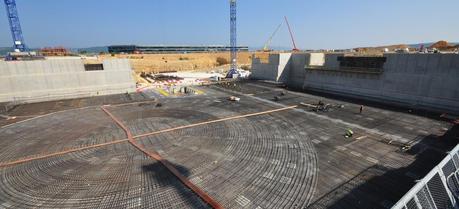 The Tokamak Pit in July 2013. (Credit: ITER)
The Tokamak Pit in July 2013. (Credit: ITER)In 2012, the ITER project entered the third year of its Construction Phase. The 2012 ITER Organization Annual Report, just released, recounts one year in the life of the ITER Project—the highlights in every technical department, the organizational challenges faced (and the solutions set into motion), and milestones in construction and manufacturing.
ITER construction is on the move. The ground support structure and seismic isolation system for the future Tokamak Complex was completed in April 2012 after 18 months of construction—a reinforced basemat, retaining walls and 493 plinths and seismic bearings now frame the 90×130 meter (approx. 95×426 ft.) Tokamak Pit.
In 2012, ITER became the world’s first fusion device to obtain nuclear licensing following a lengthy and rigorous examination of its safety characteristics by the French nuclear regulator. Also, manufacturing activities in Member factories began to shift from process qualification to real production. The momentum is tangible: in just two years, the first on site assembly operations will begin.
Work has already began on the site of the Assembly Building, the ITER site was connected to the French electrical grid, and part of the ITER team—approximately 500 people—moved into the completed Headquarters building.
According to the report, full scale prototypes of major coil power supply components were built and successfully tested in Russia during the year. In China, contracts were awarded for the principal components of a full-scale converter prototype and a power test facility was set up and commissioned by the main supplier for tests on the ITER AC/DC converter. A test bench was also established for the coil power supply master control system. Major R&D activities were carried out in Korea that demonstrated the manufacturability of elements of the vertical stabilization and correction coil converters.
Construction began on the buildings of the Neutral Beam Test Facility (NBTF) in Padua, Italy and contracts were finalized for SPIDER, the NBTF facility that will test the full-size ITER ion source. Ongoing R&D activities for the ion cyclotron system include tests of radio frequency sources in order to identify the most reliable technology and a test stand completed in the US for the transmission lines. The Russian gyrotron prototype was successfully tested at 1 MW for 1000 seconds in 2012.
An R&D task was launched on a new highly tritiated water processing technology. Pilot-scale tritium tests with wet scrubber columns took place and progress was made in Korea on the storage and delivery of tritium. The development of a disruption mitigation system for ITER continues through experimental and modeling collaborations with major fusion facilities and international experts. A potential technology for suppressing edge localized modes (ELMs) at levels nearing the requirements of ITER was demonstrated at the DIII-D tokamak in the US.
The ITER Organization 2012 Annual Report and 2012 Financial Statements are available online at ITER’s Publication Center.

